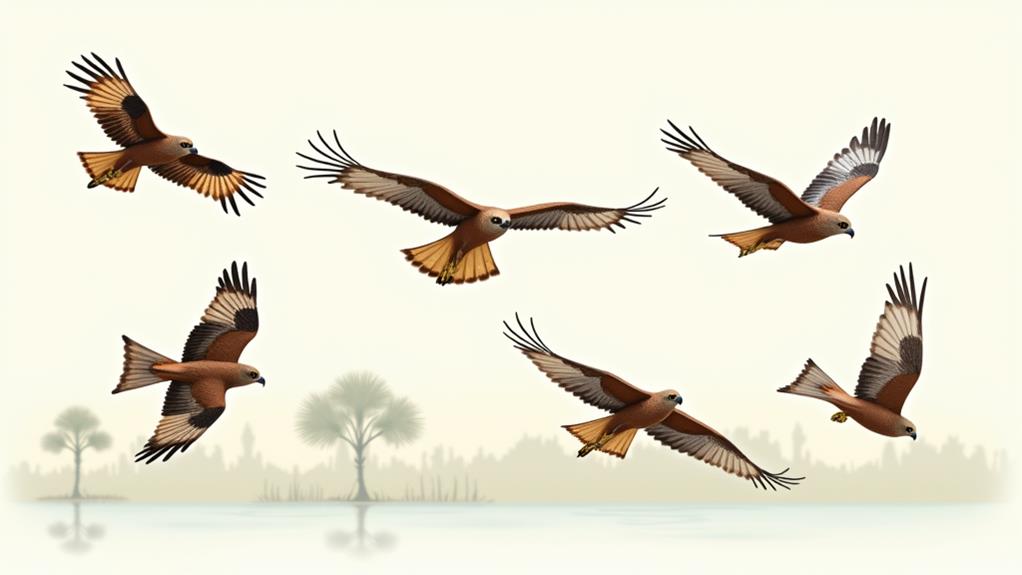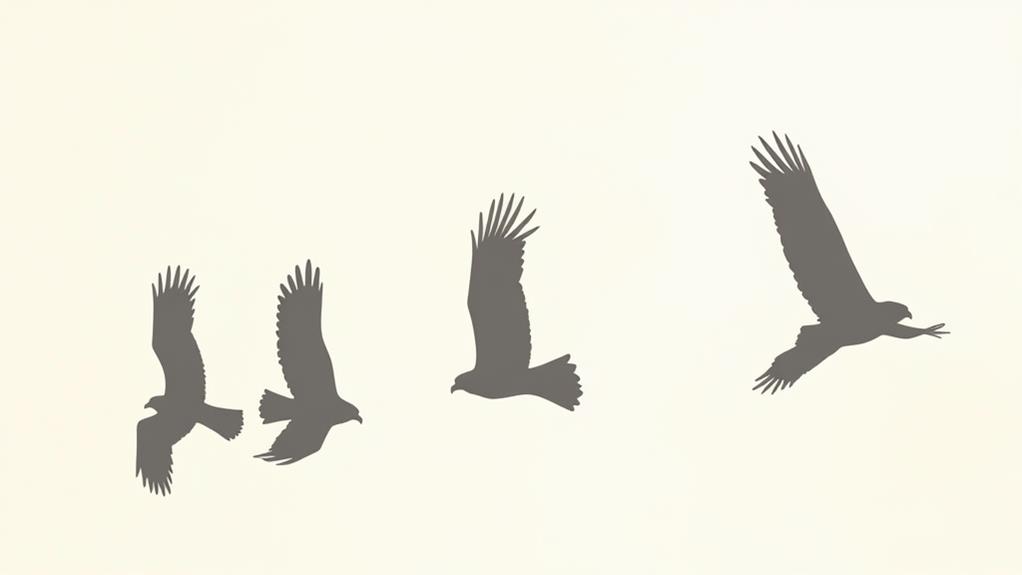As you venture into the Sunshine State's great outdoors, you might find yourself wondering about those majestic birds of prey soaring overhead – specifically, the hawks of Florida. It's not just about spotting a bird with a sharp beak and talons; accurately identifying these birds requires a nuanced understanding of their unique characteristics. You'll need to pay attention to more than just their size and shape, as subtle differences in plumage patterns, wing markings, and behavioral traits can make all the difference in pinpointing the species. But can you tell a Red-shouldered from a Cooper's Hawk at a glance?
Key Takeaways
- Analyze body proportions, silhouette, and plumage patterns to accurately identify hawk species in Florida.
- Note the shape and pattern of wing markings, wing tip shape, and tail feathers to distinguish between species.
- Beak color, leg feathering, and vocalizations are additional key identifiers for Florida's hawk species.
- Habitat preferences and hunting strategies can aid in identification, as different species favor specific environments and tactics.
- Pay attention to migration patterns and timing to understand the seasonal presence of different hawk species in Florida.
Hawk Size and Shape Matters

As you venture into the world of hawk identification, you'll quickly realize that hawk size and shape matter greatly.
Accurate identification relies on analyzing body proportions and silhouette analysis. When observing a hawk, take note of its overall length, wingspan, and weight. These physical characteristics can help distinguish between species.
For instance, the Red-shouldered Hawk is relatively small, measuring around 17-24 inches in length, with a wingspan of approximately 40-50 inches.
In contrast, the Swainson's Hawk is larger, reaching lengths of 18-22 inches and wingspans of 47-60 inches.
During silhouette analysis, focus on the hawk's shape and outline.
Note the shape of the wings, tail, and head. The Broad-winged Hawk, for example, has a distinctive broad wing shape and a fan-shaped tail.
Meanwhile, the Cooper's Hawk has a more slender wing shape and a rounded tail.
Plumage Patterns to Look For
When observing a hawk's plumage, you'll want to examine the wings closely, as the pattern of markings can be a key identifier.
Look for the presence or absence of bars, streaks, or patches on the wings, as these characteristics can distinguish one species from another.
Additionally, take note of the tail feathers, which can exhibit unique shapes, lengths, and coloration that are specific to certain species.
Wing Markings Matter
Patterns of light and shadow dance across the wings of Florida's hawks, revealing subtle yet crucial details that distinguish one species from another.
As you observe the wing markings, pay attention to the shape and color of the feathers, as well as the pattern of light and dark bands. The Red-shouldered Hawk, for example, has a distinctive wing pattern featuring a pale crescent shape on the upperwing, while the Broad-winged Hawk displays a broad, dark band across its wing.
When you're in the field, wingbeat speed can be a useful identifier. The Swainson's Hawk, with its slow, deliberate wingbeats, can be distinguished from the faster, more energetic wingbeats of the Cooper's Hawk.
Additionally, examine the feather edges, which can be either rounded or pointed. The Sharp-shinned Hawk's feathers have rounded edges, while the Northern Harrier's feathers have pointed edges.
Tail Feathers Differ
You've examined the wing markings, but now it's time to shift your attention to the tail feathers, where subtle differences in plumage patterns can further aid in identifying Florida's hawks.
When observing the tail feathers, note the length, as this can be a distinguishing characteristic. For instance, the Red-shouldered Hawk's tail feathers are relatively short, measuring around 3-4 inches, whereas the Swainson's Hawk's tail feathers are longer, reaching up to 5-6 inches.
In addition to length, tail feather color is another key identifier. The Red-tailed Hawk's tail feathers are a deep reddish-brown color, while the Broad-winged Hawk's are more grayish-brown with a distinctive black band near the end.
The Short-tailed Hawk's tail feathers, on the other hand, display a striking black and white banded pattern.
Wing Shape and Flight Style

When observing hawks in flight, you'll want to pay attention to the shape of their wing tips, which can be rounded, pointed, or notched, depending on the species.
You'll also notice distinct soaring flight patterns, such as the height and duration of their glides, as well as the angle and speed of their wingbeats.
Wing Tip Shape
As you observe a hawk in flight, the wing tip shape becomes a crucial distinguishing feature, particularly in species with similar plumage patterns.
The wing tip shape can be broadly categorized into two types: rounded or pointed. Rounded wing tips are characteristic of broad-winged hawks, such as the Red-shouldered Hawk, whereas pointed wing tips are commonly seen in slender-winged hawks, like the Swallow-tailed Kite.
A key aspect of wing tip shape is the presence or absence of a wing notch. A wing notch is a small indentation at the tip of the wing, typically seen in species with pointed wing tips.
The wing notch presence can be an essential identifier, especially when distinguishing between similar species. Additionally, the wing curve angle is another vital feature to observe. The wing curve angle refers to the degree of curvature of the wing from the body to the tip.
A more pronounced wing curve angle is often associated with broad-winged hawks, whereas a shallower curve is characteristic of slender-winged hawks. By carefully examining the wing tip shape, notch presence, and curve angle, you can accurately identify the hawk species you're observing.
Soaring Flight Patterns
Soaring flight patterns, characterized by wing shape and flight style, offer another key dimension in identifying hawks of Florida.
As you observe a hawk in flight, pay attention to its wing shape and how it moves through the air. A broad-winged hawk, like the Red-shouldered Hawk, will have a more leisurely, rocking motion as it soars to great heights.
In contrast, a slender-winged hawk, such as the Swallow-tailed Kite, will exhibit a faster, more agile flight pattern.
When a hawk reaches soaring heights, it will often enter a steady glide, using thermals to stay aloft without flapping its wings.
This glide can be a distinguishing feature, as some hawks will hold their wings in a slight dihedral (upward angle) while others will keep them flat.
You might notice that a Cooper's Hawk tends to hold its wings more horizontal, whereas a Sharp-shinned Hawk will often display a more pronounced dihedral.
Beak Color and Leg Feathering
Perched atop a cypress tree, you're scrutinizing a hawk's visage, and its beak color is one of the first characteristics to catch your attention.
Beak color can vary significantly among Florida's hawk species, ranging from pale yellow to dark gray. The Red-shouldered Hawk, for instance, boasts a dark gray beak with a slight blue-gray tint, while the Swainson's Hawk has a pale yellow beak with a darker tip.
Beak strength variations are also crucial in identification, as some species have stronger, more hooked beaks adapted for tearing flesh, whereas others have weaker, more pointed beaks suited for catching small prey.
Moving down to the legs, you'll notice the texture and feathering patterns can also aid in identification.
The Rough-legged Hawk, for example, has feathered legs with a soft, fluffy texture, whereas the Broad-winged Hawk has bare legs with a scaly texture.
Leg feather texture can be particularly useful when distinguishing between species that share similar plumage patterns.
Habitat and Hunting Grounds

You find yourself standing in a wetland, surrounded by mangroves, and you're trying to pinpoint the habitat preferences of the hawk you're observing.
As you scan the area, you notice the hawk's affinity for forest edges, where the transition from dense canopy to open space creates a unique microclimate.
Here, the hawk can capitalize on the abundance of prey species that thrive in these ecotonal zones.
As you move closer to the wetland fringes, you observe the hawk's hunting strategy.
It perches atop a mangrove branch, scanning the marshy grasses and shallow waters below for unsuspecting rodents, reptiles, and amphibians.
The hawk's exceptional eyesight allows it to detect even the slightest movement, and its agility enables it to swoop down and capture prey with precision.
Vocalizations and Calls
As the hawk claims its territory, its vocalizations pierce the air, a series of high-pitched screams and whistles that resonate through the wetland.
You may hear these calls during the breeding season, when hawks are defending their territory or communicating with potential mates.
When listening to hawk vocalizations, you'll notice call variations that can be used to identify species.
For example:
- Red-shouldered Hawks produce a loud, piercing "kee-yer" call, often repeated in a series.
- Swainson's Hawks emit a high-pitched, nasal "kreee" call, usually given in flight.
- Broad-winged Hawks make a sharp, whistled "wik-wik-wik" call, often heard during migration.
- Cooper's Hawks produce a series of high-pitched, staccato "chips" when alarmed or excited.
These calls can be an essential tool for identifying hawks, especially when combined with visual observations.
When multiple hawks gather, their calls create a hawk chorus, a cacophony of sounds that can be thrilling to experience.
Migration Patterns and Timing

Migration Patterns and Timing
Florida's hawk populations undergo significant shifts during migration, with certain species arriving or departing in response to changing environmental conditions.
As you explore the state's skies, you'll notice that some hawks follow specific Florida routes, taking advantage of favorable winds and topography.
During spring, you can expect to see Broad-winged Hawks and Swainson's Hawks migrating north through Florida's panhandle and central regions.
These species typically peak in late March to early April, with the majority of birds passing through in a short, intense period.
In contrast, Red-shouldered Hawks, a year-round resident, are less migratory, but may still make local movements in response to changes in food availability.
To increase your chances of spotting these birds, focus on areas with suitable habitat, such as forests, grasslands, and wetlands, particularly during peak spring timings.
Frequently Asked Questions
Do Hawks Make Good Pets?
You're wondering if hawks make good pets? While possible, it's crucial to consider hawk socialization and training, which require extensive expertise and resources, making it challenging for most individuals to provide the necessary care and attention.
Are Hawks a Threat to Small Pets?
You should be aware that hawks can be a significant threat to small pets, as they're natural predators; hawk attacks can occur, especially if you're not taking proper pet safety measures, such as providing secure enclosures or supervising outdoor time.
Can I Feed Hawks in My Backyard?
As you consider feeding hawks in your backyard, remember the farmer who unwittingly subsidized a fox's meal ticket by feeding its prey, illustrating the unintended consequences of meddling with nature's balance; hawk watching enthusiasts advise against bird feeding, as it can alter behavior and create dependency.
How Do I Deter Hawks From My Property?
To deter hawks from your property, you'll need to focus on hawk proofing by removing attractants and using visual deterrents like shiny reflective surfaces, balloons, or predator decoys to create an uninviting environment, making it less appealing for them to visit or stay.
Are Hawks Protected by Law in Florida?
You should know that hawks are indeed protected by law in Florida, and harming or harassing them can result in legal consequences, as they're an integral part of conservation efforts, ensuring ecosystem balance and biodiversity.
Conclusion
As you wrap up your hawk-watching adventure, remember that identifying hawks of Florida is a piece of cake, but only if you've done your homework. Don't count your chickens before they hatch – a single misidentified characteristic can throw you off track. By paying attention to size and shape, plumage patterns, wing shape and flight style, beak color and leg feathering, habitat and hunting grounds, vocalizations, and migration patterns, you'll be well on your way to becoming a hawk expert.





